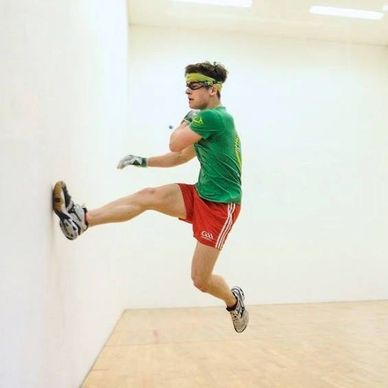History of Handball
“Handball is the oldest game played with a ball”
“Handball is the oldest game played with a ball”
“Handball is the oldest game played with a ball”
.jpg/:/cr=t:4.06%25,l:17.76%25,w:76.44%25,h:94.34%25/rs=w:388,h:388,cg:true,m)
This quote is from Robert Ripley, of “Believe It or Not” fame. Homer talks of “the princess of Corcepa with her maidens amusing themselves with handball.” Edward III prohibited by proclamation the playing of handball because men were ignoring their responsibilities in his army by not practicing archery.
The game took hold in the 16th through 18th centuries in England and Ireland. The game’s name at that time was called “fives” because of the five fingers of the hand. The court was similar to the three-wall variety of today, but smaller in size. In England a four-wall court was adopted to the game at the academic institution of Rugby, and called Rugby Fives. This court was also smaller than today’s facilities and did not have a ceiling.
In the 18th century in Ireland, every county had its champions and the game was introduced to the United States in the 1840’s by Irish immigrants. First tried on a professional scale in the U.S., lack of spectators hindered the development of the game. Also, because of the expense of court construction, the popularity shifted to one-wall play, the New York area became the centre of development.
The 1900’s
“Handball is the oldest game played with a ball”
“Handball is the oldest game played with a ball”

One-wall handball continued to develop along the beaches near New York, and spread through the East by 1910. Thereafter the game grew in all directions. Much credit for the development of the game must be given to the Y.M.C.A.’s, who still play a major part in the organizing of tournaments and developing young players. (this portion of handball development has now become the prime focus of national U.S. universities).
As a competitive amateur sport, the 1950’s saw the first National U.S. Handball Championships. Since that time regular yearly championships have been held, and the professional element has been re-introduced. All of this effort, plus the Canadian adoption of the game and National/Provincial championships have added to the success and continued growth of the game.
In addition, the fine co-operation of the United States Handball Association in providing resources for touring professionals to travel in Canada, plus assisting in the subsidizing of top ranked U.S. players to play in Canadian tournaments, has laid a fine foundation for today’s fast moving game.
Present Day
“Handball is the oldest game played with a ball”
Present Day

The two global powerhouses in the game of handball continue to be Ireland and the USA with both boasting multiple world championships over the decades. Other stronghold countries are Canada, Mexico, Australia, Puerto Rico, UK, and Spain; as well as emerging nations Holland, Italy, Belgium, Argentina, Japan and India to name a few.
The 4-Wall game faces challenges as courts around the world are being replaced with fitness studios, but handball remains one of the best forms of crossfit training on the planet. The 1-Wall game or "Wallball" continues to grow due to its simplicity and motto of "one wall, one ball". Wallball courts continue to pop up at a rapid rate. There have been rumours in the past of a push for inclusion in the Olympic Games.
Canadian Handball is going through a rebirth as a select number of clubs in the nation are flourishing. The commitment of our junior coaches have drawn in a whole new group of young players eager to learn the game. After a Covid hiatus, the 4-Wall Nationals are back with as many as 80 participants each of the last two years. The 1-Wall community continues to thrive during the summer months.
Copyright © 2024 Canadian Handball Association - All Rights Reserved.
Powered by GoDaddy

Canadian Nationals
The Canadian Handball Association is proud to present the 2025 Canadian 4-Wall Handball Championships, May 7-10, 2025 in Sherwood Park, AB.
The event will feature men’s and women’s small ball singles and doubles, with Canada’s best players competing for the most prestigious prize in Canadian Handball!
This website uses cookies.
We use cookies to analyze website traffic and optimize your website experience. By accepting our use of cookies, your data will be aggregated with all other user data.